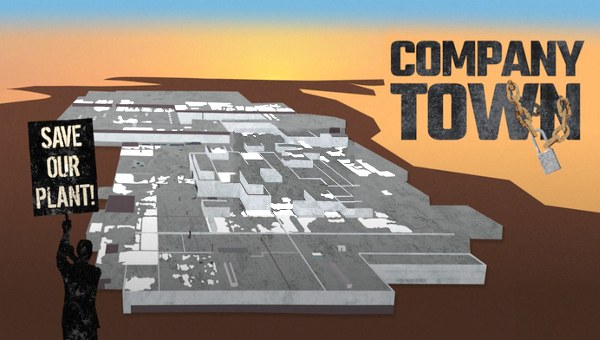Not Completely a Company Town
Peter Findlay’s documentary film Company Town provides a welcome opening to initiate discussion and debate about the closure of General Motor’s once massive (it had 23,000 workers at one time) and historically central auto and truck complex and supplier plants. Behind the film’s basic narrative is a countdown from the period between the announcement (November 2018) of the closure and the actual end of production (December 2019). It creates space to raise issues such as the power and strategic orientation of the union and its leadership, the nature of the industry and competition in this era of late neoliberal capitalism, the consciousness and lives of auto and parts workers, and the possibilities of alternatives.

The story line is told on a number of different levels: the failed efforts of the national union leadership to deal with the crisis (particularly focusing on Unifor national president Jerry Dias); a group of individual workers affected by the closure; and an alternative movement championed by a small group of activists, personified by one of the GM workers, Rebecca Keetch.
Follow the Leader
In a series of narrative segments, the film follows Unifor president Jerry Dias’s attempts to prevent the closure and ultimately negotiate severance packages for GM and supplier workers. It copies the format of earlier Canadian Auto Workers (CAW) documentaries, with snippets of interviews and comments, and cuts of internal union meetings, peppered by dramatic-sounding musical scoring, but it uses written narration rather than the dramatic voiceover provided in earlier films.
While it’s supposed to portray a dramatic effort to stop the closure, what it actually does is expose the utter impotence, systemic weakness, and lack of political perspective of the union and its leader. Unlike the iconic Final Offer (1984) and other early CAW documentaries such as No Looking Back (1985), this is no picture of a strategically sophisticated group of leaders debating and strategizing how to defeat a larger US-based auto company. We don’t see them fighting against moves to deepen and institutionalize concessions, or organizing for an independent Canadian union. There is no strategy to undermine employer efforts to, in turn, undermine union independence from employer competitive schemes, or to gain the confidence and deepen the understanding of the membership, and in the process, build the union.
Instead, it is a story of defensiveness, strategic myopia, an absence of confident and sophisticated leadership, empty rhetorical threats, seemingly more concerned with putting on a show and pacifying the membership than providing leadership in struggle. In this, the pseudo-dramatic hoopla of the score and the intimate comments of the president and his lieutenants often sound hollow.
What the film reveals is a series of retreats, each punctuated by ineffectual tactical approaches and rhetorical threats about waging “a helluva fight.” First, Dias and company attempt to force GM to provide a promised new product for the facility. Then they initiate a campaign to convince car buyers not to purchase vehicles made in Mexico. When that doesn’t work, they negotiate a “footprint” for a small number of after-market jobs and a series of severance and other benefits and retraining promises. Even with that, it left Dias with a clear defeat, blaming GM’s very real betrayal.
Next, Dias and his assistants are pictured demanding better severance and benefits for the orphaned workers from the supplier companies. There is an embarrassing moment when supplier union leaders and workers are demanding action, and Dias’s assistant can only promise that they will set a “deadline.” And, after a lot of bluster and bluff, we are presented with an intention to get GM workers to slow down and thereby pressure the company to force the suppliers to enrich their benefit packages. But there is no word about whether that ever happened – or whether anything was gained.
Next, we are presented with… nothing. Dias claims (rightly so) that they have been betrayed by GM and that the next round of negotiations could provide some kind of new opportunity.
With all of the dramatic scene splicing and musical score (with the brilliant harmonica playing of Roly Platt), there is really nothing left here, other than lots of sadness, sympathy, and a refusal to consider more radical or imaginative alternatives.
Workers as Victims
The film also follows the fortunes and attitudes of four, and later, a fifth worker. They include two supplier workers, the local union president who works at GM, a woman GM worker, and later, another woman GM worker activist who leads a movement to challenge the corporation’s and union’s perspective.
For the most part, these workers are seen as victims – which, on one level, they are – of the callousness and greed of the corporation, and the lack of leadership and collective organization of the union. They articulate their frustration with the company’s dishonesty and betrayal, their fears about their finances and job prospects, and their anger with the union’s inability or unwillingness to organize any serious resistance. The supplier workers are particularly angered by what they perceive as the union’s neglect of their concerns and apparent surrender without a fight.
One supplier worker, Kevin, who becomes involved in an alternative movement, is asked, “Are you angry with GM?” and his response is “Not surprised that GM is greedy, but I was angry about how I was treated by the union.”
While there is a lot of anger and frustration here, what is missing is any collective push from below for action to limit GM’s and the suppliers’ options, or for leadership from above to build any confidence in a strategy to pressure the employers. With 3,000 workers at GM and 2,000 more at the suppliers, nothing more than a series of short work refusals – at first encouraged, but then shut down by the union – ever took place. The inability of these workers to influence the union is obvious, as well.
This reflects the accumulated pressures on workers over the past couple of decades, the enhancement of employer power in the era of free trade and neoliberalism, the intense levels of competition in the auto industry, and the clear decline of fossil fuel vehicles on the horizon. In addition, there is the lack of any real alternative voice putting forward political alternatives to the constant increase in plant closures and disinvestment in Canada. The union has served only to reinforce these trends as it accepted the ongoing drumbeat of closures of the Oshawa complex over the year. They included fabrication, truck, and car plant closures – bringing only symbolic or no challenge, as well as its lack of vision that could take it beyond dependence on the competitive decisions of US auto companies.
The union consistently met each setback with increased concessions to lower costs and encourage future investment, and by going along with the corporation as partners, of a sort. This meant begging governments to subsidize investments (often, euphemistically engaging in campaigns such as “manufacturing matters” promising to address disinvestment with progressive industrial policies, but in reality, supporting their employers’ push for government bribes). Some of the more odious concessions accepted by the union included allowing GM to outsource various jobs to lower-wage contractors and hiring different categories or “tiers” of workers, with different wage levels, benefits, seniority, and job security, performing the same jobs as “legacy” workers with traditional rights and benefits. (During the last set of GM bargaining, the union made major concessions in exchange for the promise of a new product that never came.)
Over time, experiences such as these affect the thinking and confidence of workers. They reinforce an existing sense of isolation, weakness, and defeat, not to mention the real dependence of workers on the employer, without a sense of independence and struggle from the union. Adding to the problem was a lack of a socialist political movement, building or posing alternatives to corporate power.
These experiences also reinforce a sense that high quality levels and community support would somehow cement GM’s allegiance to Oshawa. The old notion of “Generous Motors” has its roots in identification with the employer’s fortunes rather than the rest of the working class. This is linked to a more recent tradition of conservatism within Local 222, which has never really been effectively challenged by progressives within the leadership of the CAW, Unifor, or a working-class-based socialist left. (It was no accident, for example, that the Oshawa local was home to a relatively large group of supporters of Mike Harris’s “Common Sense Revolution” in the late 1990s and was, significantly, not picked as a site of one of the Ontario one-day general strikes during that period.)
Workers as Protagonists – Alternative Voices
The film points beyond this dismal scenario. It actually features an alternative perspective. Although not one of the “original” workers identified in the initial story of the closure narrative, Rebecca, one of the second-tier workers at GM, is given a voice that is absolutely critical to this documentary. She, along with Kevin, the worker at a parts supplier, got involved with and helped to build an organization called Green Jobs Oshawa (GJO). It argues that the Oshawa complex should be nationalized, and could produce battery electric vehicles for use by governments and public transit for various transportation needs, separate from the private competitive markets that rule the operation of private auto producers.
Even more, as one can see from Rebecca’s interviews, her speeches to environmental rallies and demonstrations, and her conversations at Green Job Oshawa meetings (all filmed for the documentary), GJO is both a workers’ political movement, and an effort to address the climate emergency. She calls for provision of well-paying, secure union jobs as part of what the environmental movement calls “just transition” – workers transitioning away from a fossil-fueled economy, instead of subsisting on support payments, and ultimately, having to accept precarious employment of various sorts. The alternative use for the GM plant would not be based on producing individual passenger vehicles in competition with corporate rivals, but rather, providing vehicles for public use and serving as a potential hub for further manufacturing projects in a new green economy, producing for collective, community needs. Moreover, production of new personal vehicles is ruled out – regardless of what materials they are made of – because it would contribute to the climate crisis.
The film doesn’t shy away from demonstrating the difficulties worker-activists/organizers face in convincing their co-workers about such alternatives. Workers have little faith in alternatives to employment at the GM’s of the world, or that public ownership and moving outside the orbit of private production of consumer items in competitive markets would offer them real transitions. This has been reinforced by both their personal experiences and the opposition (or derision) by the union to the GJO approach. The film includes a couple of short clips where Jerry Dias dismisses Rebecca’s proposals and those of her colleagues as “textbook socialists” and “academic” and “unreal.” The local union took a similar stand, although it isn’t shown in the film. (It is interesting that while Dias and the Unifor leadership consider the GJO demands to be “unrealistic,” they maintained that somehow pressuring GM to re-invest in Oshawa by presenting advertisements at NFL superbowl and hockey playoff broadcasts would shift public opinion and force GM to invest in Oshawa. This public shaming of GM was warmly greeted by workers in Oshawa, but it hardly constituted a realistic challenge to the corporation’s power.)
Rebecca and her colleagues, including Kevin Cragg, Tony Leah (GM retiree and chair of the political action committee of Local 222), Sam Gindin (former CAW Assistant to the union’s President and Research Director), Tiffany Balducci from CUPE and the Durham Labour Council, Chris White and others (including this reviewer) are clear that they don’t expect to be instantly successful. Gindin says that this is a moment of necessary transformation of both unions and politics, but it remains on the level of potential. Rebecca notes that they may not succeed in Oshawa but just might inspire others to attempt and win similar efforts to convert carbon-based manufacturing facilities into socially useful, worker-managed, publicly owned workplaces.
What Can We Learn From This – What Should We Do?
This film can serve a number of purposes. On one level, it can demonstrate just how difficult, and perhaps impossible, it is to fight for jobs and investment in the traditional manner in this era. Unifor, in the local and National leadership, couldn’t see beyond trying to force GM to invest in Oshawa through various forms of public pressure. The advertisements appealing to consumers not to buy Mexican-made cars only seemed to target Mexican workers and weren’t tied to a plan for building a different auto industry.
There were no plans to organize any real collective resistance in the workplaces of Local 222’s auto sector. Had there been a strategy of demanding government ownership and the building of a different kind of product, the union could have organized plant occupations, demonstrating to GM and the government that after receiving $11-billion in subsidies, the corporation isn’t the ‘legitimate’ owner of the facility. It could have created confidence in the workers to shape the future of the workplace and could have created openings to move further than simply demanding good severance. Like the experience with Caterpillar some years ago, an opportunity was clearly wasted. But this time, there was an alternative voice, and it is still organizing.
Thinking that the only future for the Oshawa facility must include private corporate investment ignores the reality that employers like GM move their investments to address the need to maximize returns on investment, and any new product they make will be subject to cutthroat competition from others doing the same. Given the power of corporations to move where they wish without restrictions (unlike the period when the auto pact forced employers to invest here), traditional forms of pressure won’t really work. Dias and the Unifor leadership know this. It makes their adoption of ad campaigns and their dismissal of the Green Jobs Oshawa demands as ‘unrealistic’ all the more problematic.
Dias’s hypocritical support for the renewal of the NAFTA free trade agreement and his argument that somehow this would bring some level of security for auto workers was also shown to be a failure. Free trade is the problem, not a solution. The embarrassing chumminess with Prime Minister Trudeau at last year’s negotiations with Trump’s representatives only made things worse.
The union had a choice here, presented by the workers who began the Green Jobs Oshawa project, but the union leadership really had no intention of considering it. It really was seen as something way beyond their traditional way of understanding ‘reality’. It makes the union leadership look kind of victimized, not only by GM’s treachery but also by their own limited outlook and understanding.
A Different Story
The comparisons with the story told in the 1984 National Film Board documentary Final Offer are stark and instructive. That film showed the struggles on the shop floor, worker resistance to management pressure, and union support of the members. It framed the battle against concessions as the beginning of a longer war challenging a new corporate effort to get the union to accept a ‘partnership’ for competitiveness that would undermine decades of building and collective struggle. It was effectively the beginning of neoliberalism, and the union, under Bob White’s leadership, was in a position to take it on (as they also, simultaneously fought free trade, which they helped facilitate in 2020). Looming over the struggle was the issue of an eventual break with the US-controlled UAW, and the possibility (and challenges) of ultimately creating an independent Canadian auto union. White and the others didn’t shy away from that or call it “unrealistic.”
They resisted and won the battle against GM in 1984. For over a decade and a half, the CAW continued to oppose neoliberalism, as well as its effects on the union and industries, such as the auto industry. But eventually, the CAW suffered a strategic defeat, as did so many unions in Canada and the world. Plants closed; neoliberal policies engulfed the world.
Without a socialist left presenting an alternative, inside and outside the union movement, the union (and brother and sister unions in Canada and elsewhere) didn’t take up the new challenge of radicalizing its approach and deepening the understanding of the membership. That would have required a transformation, that would position the union to pose alternatives to dependence on corporate power and competitiveness and to challenge the governments to play a role other than that of facilitating free trade and giving subsidies for the promise of investment.
What might have happened if the union had been able to make those changes? If it had continued to struggle, build, and educate the membership? Certainly, we can only speculate – and it’s not certain that such activism would have even been possible to sustain over this period. Yet, even with the loss of so many members and larger productive capacity, it might have left the CAW, and later Unifor, with an openness to the kinds of alternative perspectives that activists around Green Jobs Oshawa propose.
New Possibilities
On another level, the film demonstrates that a different path is possible, although it requires fundamental changes that most likely point beyond the struggle in Oshawa. It certainly requires a change in thinking, rejecting the idea that the future of manufacturing facilities like GM Oshawa depend on private capitalist investment. In order to provide decent, well-paying unionized jobs, produce products and services that serve the interests of the community, the working class as a whole, and the environment, they need to be part of a larger, publicly-funded, planned process. Any new investment (although welcomed) by GM and their cohorts would be subject to the whims of the marketplace and private investors seeking unlimited growth and competitive returns. New investment as part of a battery electric vehicle project for government and community use, publicly owned and democratically managed, would provide a seed for worker security and future efforts.
This is not going to happen in Oshawa in the immediate future, but it can be part of a larger and longer-term effort to build a country-wide movement to convert manufacturing facilities for social use, challenging fossil-fueled production and extraction, based on a larger plan, and involving workers in the process. It requires, first of all, gaining and building local community support. Then, it requires building a network of activists in workplaces and communities across the country; the environmental movement, which before the pandemic struck, organized monthly student strikes that closed schools and involved young people. It means working to build a base in union institutions and labour councils, and creating conversion projects in various workplaces. Links between these nodes are being made now and will inspire more participation and confidence from workers over time.
Hopefully, in the end, many of us involved in this movement see Company Town as an organizing tool that sheds light on the forces, structures, and potentials (as well as the dead ends) that face efforts to create jobs for working people. •






